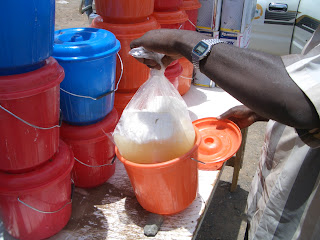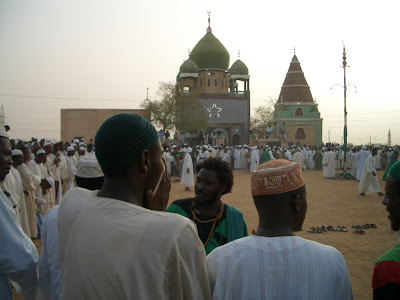Hi all!!!
Thanks for reading this blog. It seems that the response has been very positive.
I will tell you what I did today:
- I tried to respond to the question of: OK, PMM is cool, but what do we do then? What kind of people one should invite to be part of the PMSD process.
- I went through the M&E framework for both projects.
For the first question:
Selecting your allies:- Transforming a market system is a 'war' between those who want to maintain the status quo and those who need or want to change it. In PMSD we are like a football coach or a general and our task is to assemble at least two winning teams of allies who will help us transform the market system: IG and MoG.
- Avoid the 'hijackers' (I copied this term from Khalid): We need to make sure that we take every step necessary to avoid people who in reality want to have a free ride or want to block the process.
- How to do it?
- For the MoG: Invite leading, influential, inspiring, reputable, educated, experienced and/or trusted members of the community. The MoG has to be able to engage with potential buyers, policy-makers and service providers; explore business and lobbying opportunities, develop win-win relationships and make sure that the farmers they represent get the benefits. Not an easy task, is it? This is why we have to be very strategic when we assemble this team. Of course, we have to pay attention to whom the communities want to nominate as their representatives, but we have to make sure that they know the role and responsibilities of this vital team.
- For the IG: Use the market map to identify the key actors who could have an interest in improving, not the whole system as we have been talking about before, but critical issues that we identified in the preliminary PMM.
Brainstorm using the map and list all the actors, do not stop to reflect too much here; they can be at any level of the market map. Then, use the power-relevance matrix (a very simple tool that we invented yesterday) to identify who is a relevant actor for each issue and who has the power to promote changes in that issue.
The matrix is a Cartesian plane with two axes:
- Horizontal: from less relevant to more relevant. E.g. the MoA is extremely relevant to solve issues related to extension services.
- Vertical: from less powerful to more powerful. E.g. a leader of a political party can have lots of power to propose a change in the tax legislation in the Parliament.
When you have located the actors here you will end up with dots spread all over the plane. Take the following decisions for each quadrant:
Quadrant I (relevant and powerful): be proactive and do your best to get them on board. Call them, visit them, and explain the project to them. Show them why the project is important for them and what they will win if they join the IG (avoid false promises). Do not give up. If they refuse, try to get the others on board and call him/her again (powerful actors attract other powerful actors).
Quadrant II (relevant but not powerful): be open minded. If they are very relevant for that issue and they call you and tell you that they want to join the IG, listen to what they have to say and see how you can use their contributions strategically. For example, a very reputable researcher who on his own cannot do much to change the issue but can provide very valuable evidence to the powerful actors in quadrant I.
Quadrant III: (not relevant and not powerful): run away! Do not let them waste your time. If you are unlucky enough that they call you and beg you to let them be part of the IG, explain to them diplomatically that the group has very specific roles and that you will call him/her for more valuable contributions later. Never underestimate an enthusiastic potential ally; you might need him/her later
Quadrant IV (powerful but not very relevant): again, be open minded. Listen to what the have to say. (See quadrant II). E.g. if the issue is taxation, and the minister of health calls you, listen how he can add value to the process, explain to him the project and your strategic needs… maybe she is a good friend of that relevant and powerful actor who rejected your invitation the first time!
When you have identified the actors in quadrant I (normally institutions or organisations), put a name and a phone number on it. I.e. identify within the organisation who is the right person to invite. Ask your colleagues and other people who know the organisation from inside. Be creative and tenacious.
If the number of actors in quadrant I is too large (not likely), prioritise. Maybe up to five actors is enough to get the process started. What criteria should we use to filter the group further then?: Commitment, passion, values.
The experience of the Hibiscus Forum is leading me to believe that large IGs are a liability instead of an asset if we create them with a supply-led logic. Instead, we need to begin with a small but highly committed group of IG actors, who deeply believe in the project, and then spread the voice about their achievements… my hypothesis is that other committed actors will come to join. It is preferably that the process to join the IG is demanding in terms of commitment, so that we create self-selection of highly committed actors (we do not want free-riders here).
If you identified two or three critical issues (e.g. taxation, certification, extension), you will end up with the same number of sub-groups (I call them task forces). They constitute your IG. Promote a sense of identity and belonging but let them work on their own and give them very clear tasks according to the needs of the project. Create spaces for them to share progress periodically (maybe a plenary every two months or so). Do not saturate them but make them feel that you are there… quietly breathing on their neck. Do everything you can to nurture them with contacts, information, resources, spaces to work and meet, etc. Give them public recognition (maybe a press conference when they have something important to say). Invite them to the field, help them understand the reality of the project in the ground. Create communication between them and the MoG and other farmers. Just be creative!
The team was very excited about this tool because they did not have clear criteria to select members. They said that it is also useful to reject inappropriate actors in a diplomatic way because they now have a rationale and 'objective' criteria behind the decision to reject them (the typical line 'we'll get in touch with you if we need you' comes very handy here) ;-)
In a previous session we also talked about the importance to ‘sell’ the project in a way that it makes sense to each actor of the MoG and the IG according to their interests: if they are business people, make business sense; if they are politicians, make political-sense; if they are NGOs, donors or CBOs, make social sense; if they are farmers make ‘livelihoods sense’!
Finally, I used for the first time the categories proposed in The Tipping Point (M. Gladwell) to show them that if they wanted to create a ‘revolution’ with the project (scale-up) they needed teams (their own field team, the IG and the MoG) with a good balance between ‘salesmen’, ‘connectors’ and ‘mavens’ (or translators). They loved it!
The second part of the day was dedicated to M&E. But now I am too tired to keep on writing (it is past midnight now).
Sorry for the excessive technical stuff in this entry. I promise that next time I’ll be more fun. (I am just very excited because we are moving the approach towards very concrete applications).
Big hugs, to my readers…
 On the way from Khartoum to Um Rwuaba... selling ice seems to be a good business. I am not sure though of the display method under these conditions (55C and direct sunlight), but apparently, it works. Notice the cutting device (talking about appropriate technologies!).
On the way from Khartoum to Um Rwuaba... selling ice seems to be a good business. I am not sure though of the display method under these conditions (55C and direct sunlight), but apparently, it works. Notice the cutting device (talking about appropriate technologies!).

 Shibby (right) and Khalid (left) during the infamous 'sauna' training session with the project officers and members of the local partner Eid El Nil. They are explaining the PMSD approach. Hot but a very productive day.
Shibby (right) and Khalid (left) during the infamous 'sauna' training session with the project officers and members of the local partner Eid El Nil. They are explaining the PMSD approach. Hot but a very productive day.







.jpeg)